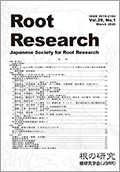
- Issue 4 Pages 77-
- Issue 3 Pages 67-
- Issue 2 Pages 57-
- Issue 1 Pages 5-
- |<
- <
- 1
- >
- >|
-
Shinsuke AGEHARA, Atsushi SANADA2020Volume 29Issue 1 Pages 5-19
Published: March 20, 2020
Released on J-STAGE: March 30, 2020
JOURNAL FREE ACCESSWe developed a scanner-based rhizotron system composed of a wood frame and acrylic sheets to perform non-destructive root evaluation. The main objective of this study was to develop a quick and inexpensive method to estimate root and shoot traits of soybean (Glycine max) seedlings using our rhizotron and ImageJ, a free image processing program. Soybean seeds were sown in rhizotrons, and root and canopy images were collected periodically over 18 days. Seedlings were sampled at the end of the experiment for additional growth measurements. Root images were analyzed using ImageJ and two commercial programs (WinRHIZO Tron for rhizotron images and WinRHIZO for washed root images). For rhizotron images, root projected area measured by ImageJ and WinRHIZO Tron showed significant linear correlations, with R2 ranging from 0.556 and 0.751. Leaf area measured non-destructively by ImageJ and destructively using a leaf area meter also showed a high linear correlation (R2 = 0.678), suggesting that ImageJ is a useful tool to evaluate both root and leaf growth of soybean seedlings. Although WinRHIZO Tron can provide additional root measurements simultaneously, it was extremely laborious and time-consuming (up to 60 min/image) compared to ImageJ (2–3 min/image). For washed root images, there was a high linear correlation (R2 = 0.919) in root projected area measured by ImageJ and WinRHIZO. These results demonstrate that our rhizotron combined with image analysis techniques using ImageJ allows non-destructive, quick, and inexpensive root and shoot growth evaluation for soybean seedlings.
View full abstractDownload PDF (4739K)
- |<
- <
- 1
- >
- >|